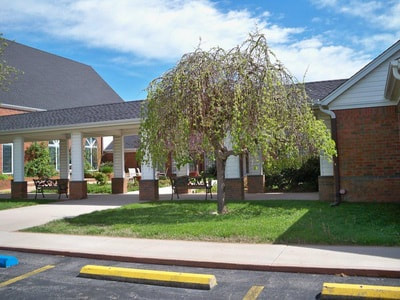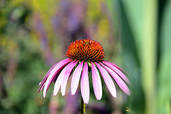|
Ozark Green Thumb BCMG Monthly e-Newsletter |
|
|
 The Baxter County Master Gardeners are a fun group of folks who enjoy sharing their love of gardening with any visitor. At our meetings we have speakers, refreshments, & fun. Come join us! Next Meeting Date: April 12th from 1:00 - 3:00 pm Meeting Place: The First Presbyterian Church 1106 Spring Street Mountain Home, AR April Speaker: Chris Stuhlinger, University Forester, Arkansas Trees Master Gardeners Monthly Radio Program: Mountain Talk Radio April 19th on 97.1 7:15 a.m. - 8:am. Master Gardener Host this month are Tommy Hagan and Ceil Gasiecki Directions: From Mountain Home Take US Hwy. 62B East through Mountain Home until you come to Cardinal Street. Cardinal Street is the intersection just past Harp's Grocery. Turn right onto Cardinal Street and travel South until you come to the first stop sign which should be Spring Street. Turn left onto Spring Street and go down the hill past the bridge and the First Presbyterian Church will be on your right hand side. From Gassville: Take Hwy. 62/412 towards Mountain Home. Once you get to Mountain Home continue on into Mountain Home on US 62B. This will take you through town till you get to Harp's Grocery and you come to Cardinal Street. Cardinal Street is the intersection just past Harp's Grocery. Turn right onto Cardinal Street and travel South until you come to the first stop sign which should be Spring Street. Turn left onto Spring Street and go down the hill past the bridge and the First Presbyterian Church will be on your right hand side.
0 Comments
 All of our garden flowers originated as wildflowers. Most were developed by breeding and selection during the gardening explosion that occurred in Europe between 1820 and 1870. Not surprisingly, in the current gold rush mania that gardening has become in the last decade, plant breeders have again gone back to the wild to look for new garden plants. In the last decade, breeders have reinvented one of these – the coneflower – to produce stunning new perennials with totally new colors. Save one, all of the six or so recognized species of coneflowers (Echinacea) are found in the Ozarks. Most are prairie plants or glade dwellers in the open woodlands. The purple coneflower (E. purpurea) has long been grown in gardens with the other species mostly left alone in the wild, at least until recently.
Beginning in 1997, Dr. Jim Ault of the Chicago Botanic Garden, began hybridizing coneflowers. He crossed the familiar purple coneflower with E. paradoxa, the yellow coneflower found in limey soils of the southern Great Plains. The several hundred seedlings produced from this first-hand cross were uniformly purplish pink. These initial hybrid seedlings - the F-1 hybrids in breeding parlance - were crossed amongst themselves and seed saved. This second generation (the F-2 generation) flowered for the first time in 2001. These seedlings segregated into a rainbow of colors ranging from pink to yellow and all shades in between. Many showed a distinctive orange color. From this population, 50 distinctive new color forms were selected. One of the best of these was Orange Meadowbrite, a 30- to 36-inch tall coneflower released in 2004. It’s like the typical purple coneflower in growth habit except for the unusual shade of its three inch wide flowers. Orange Meadobrite flowers from late May through early summer, producing blooms that are a unique shade of orange. Some call the color tangerine, which is close but still not exactly right. The color changes shades under different lighting conditions and as the blooms age. Because it has undertones of other colors besides orange, it blends well with other perennials. Uncharacteristically, Orange Meadowbrite flowers have a distinctive spicy orange fragrance. Orange Meadowbrite is a hybrid between the familiar purple coneflower and the yellow coneflower. It’s one of the many new hybrid coneflowers making their way into our gardens.Ault has produced upwards of 20,000 coneflower seedlings during the last decade and continues to release new introductions. Mango Meadowbrite (a branch sport of Orange Meadowbrite) was introduced in 2005. Ault’s 2006 release is Pixie Meadowbrite, an 18-inch tall, long flowering pink with E. tennesseensis parentage. He describes Pixie Meadowbrite as having “an incredibly long bloom time and small perky flowers”. Future releases from the Chicago program will include clones with plants having various shades of red, apricot and white. These new clones are mass produced in tissue culture and have become hot items amongst gardeners wanting the newest plant introductions. Other than requiring at least four hours of sunlight and good drainage, coneflowers are easy to grow. They do best in a rich soil and have good drought tolerance once established. Trimming off the blooms can encourage a later flush of flowers. But, because finches love to pick the seeds from the mature cones in the fall, many gardeners prefer not cutting the plants back after flowering. By: Gerald Klingaman, retired Extension Horticulturist - Ornamentals Extension News - July 28, 2006  The line between myth and reality is often unmarked, especially as we look backwards through the mist of time. Foxglove, that rocket of a flower that launches itself from a pad of large basal leaves in April and May, illustrates how we still carry with us vestiges of this fuzzy borderland into our modern age. Foxglove (Digitalis purpurea) is a biennial or short-lived perennial belonging to the snapdragon family, a native of western Europe. In its first year of life, foxglove seedlings produce a rosette of green, fleshy, simple leaves, which are unremarkable in appearance. But, in the spring, this rosette begins to shoot skyward with leaves shrinking in size as they near the flowering scape. Older plants may produce several blooming scapes, but young plants are usually unbranched. The 3-inch long, tubular purple flowers begin opening at the base of the scape, while the blooms above it are progressively smaller as they await their day of opening. The inside of the tubular flower is lighter colored and marked with irregular batches of dark brown. Hybridizers have given us an array of flower colors in this increasingly popular plant with white, pink, apricot and bicolor selections now available. The name foxglove is from the old English name "foxes glofa." It comes from an old myth that foxes must have used the flowers to magically sheath their paws as they stealthily made their nocturnal raids into the poultry yards of rural folk. The association is natural for the foxgloves grew on the wooded hillside slopes that foxes chose for their dens. The name foxglove is from the old English name "foxes glofa." It comes from an old myth that foxes must have used the flowers to magically sheath their paws as they stealthily made their nocturnal raids into the poultry yards of rural folk. The association is natural for the foxgloves grew on the wooded hillside slopes that foxes chose for their dens. In 1542, Leonhard Fuchs, after whom fuchsia is named, gave the plant it's current Latin moniker - Digitalis - for the finger (ie. digit) shaped flowers. The species epitaph purpurea was adapted by Linnaeus two centuries later. Like most plants in the European flora, foxglove was used as part of the herbal medicine chest before the development of the modern pharmacopeia. But its use was relegated to that of a general cleaning agent, to purge the body of whatever ailed it. It was not until 1775 that an English physician named William Withering, acting on a account supplied by an herbal healer, reported that a tea made from it was useful in curing dropsy, the fluid accumulation often associated with heart-related problems. Since that time, the drug digitalin has become one of the old, generic drugs doctors and HMO's consider the first line of defense against heart-related ailments. Foxglove is a mainstay of the spring garden where it can reseed freely if it finds the site to its liking. It has naturalized in the wild in Pacific Northwest and in a few areas of New England, but in the South it's propensity to procreate is much reduced. It grows in full sun or medium shade and usually persists for three or four years if it finds the site to its liking. It does best in a moderately fertile, well-drained soil that receives some water during the summer. Foxgloves are easy to grow from seed, and gardeners wanting to add them to their garden for next spring will find this easy and rewarding. Seeds can be planted outside in containers in May or June. Seed germination is easy and seedlings can usually be transplanted to a growing on container after three or four weeks. The first-year plants should be planted in their final location in the garden during September so that they can establish themselves before cold weather arrives. By: Gerald Klingaman, retired
Extension Horticulturist - Ornamentals Extension News - May 17, 2002 In this week’s article I want to mention things gardeners need to be considering for April. The following is a garden checklist:
For more information on any of the above points, contact the University of Arkansas Division of Agriculture Cooperative Extension Service at 425-2335.  Leeks, shallots, onions and garlic c0mbine to make a rich, delicious side dish. 8 servings
2 tablespoons dry breadcrumbs 2 tablespoons chopped fresh parsley Melt butter in heavy large skillet over medium heat. Add leeks, large onions,
shallots and garlic and saute untill all are tender, about 20 min. Add baby onions and cook 10 minutes longer, stirring occasionally. Mix in 2 cups whipping cream. Boil until cream is thickened to sauce consistency, about 10 minutes. Transfer vegetable cream mixture to a 6 cup shallow baking dish. (This can be prepared one day ahead. Cover and refrigerate. Return mixture to room temperature before continuing) Preheat oven to 425F. Sprinkle breadcrumbs over onion mixture. Bake untill breadcrumbs are golden brown and onion mixture bubbles, about twenty minutes. Sprinkle with parsley before serving.  This is an easy desert to prepare that looks elegant. It is delicious with coffee Serves four
Puree frozen raspberries with half the sugar. Slice the cake
and cut in i/2 inch cubes. Divide bake between 4 wine or martini glasses. Top with equal amounts puree. Gently blend mascapone with remaining sugar and vanilla. Fold in the whipped cream and put a scoop of this mixture in each glass. Top with fresh raspberries and serve immediately or chill for up to four hours. |
Archives
April 2022
|
|
